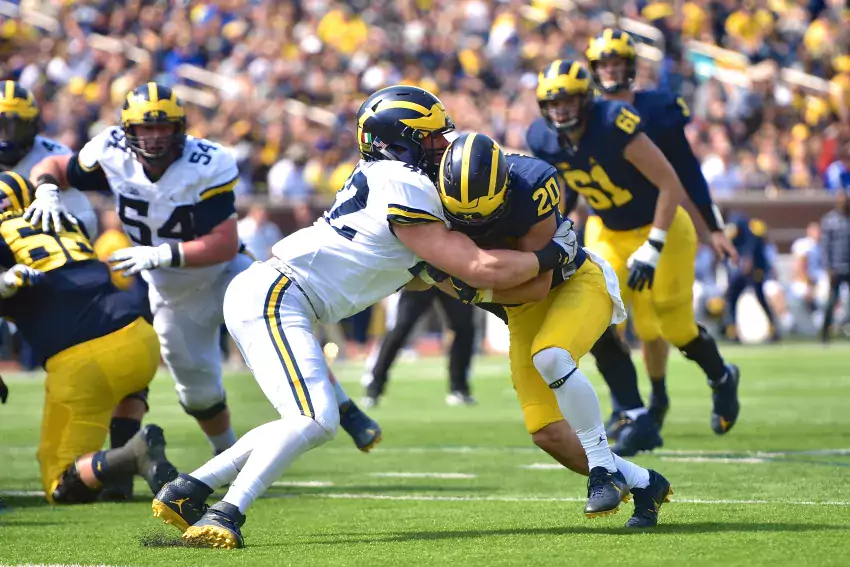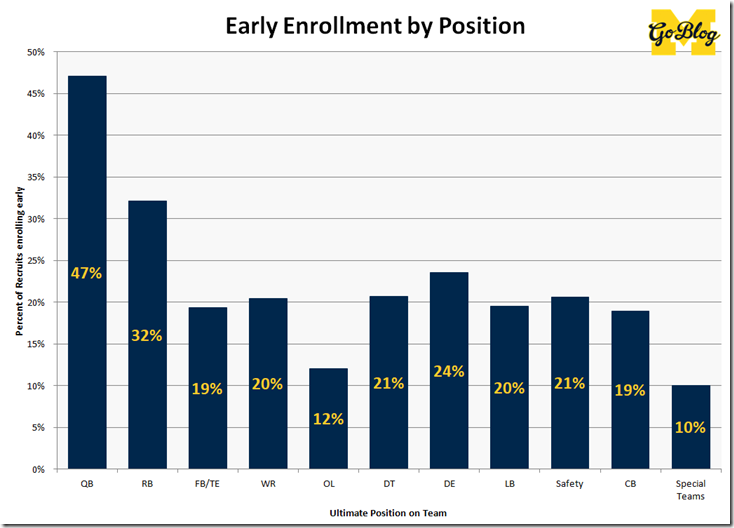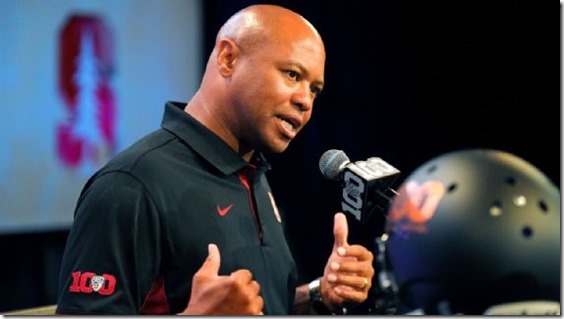early enrollees

The early enrollees are on campus now and I've got spreadsheets of data on starting, games played, recruiting ratings, and whatnot. I've been wondering how early enrollment affects careers ever since The Wolverine did a story on it when Kevin Grady was the first Michigan player to do it. This year's class is Blake Corum, Braiden McGregor, Aaron Lewis, Nikhai Hill-Green, Cornell Wheeler, and William Mohan. Can we expect anything different from them?
Who enrolls early?
The phenomenon didn't begin in college football until the early aughts, and Michigan got in on the game in 2005 with 5-star running back Kevin Grady.
Since the ramping up period, generally about a third of each class got here early, interrupted only when instability at Michigan led to instability in recruiting, and the plans of those who need to do a lot of foreplanning to graduate from high school a semester early.
With plenty of room for fluctuation it seems a quarter to 30 percent of a normal class enrolling early is the median. The exception of course has been right after a coaching change, as those classes came together late; recruits for whom enrolling early was a priority would not have signed with Michigan in those years.
I also wondered if a certain kind of recruit was more likely to get here early, and I found one that appears significant:
The "4.5-star" designation is for those guys who didn't get a 5th star but were in the top-100 to 150 of their classes. Reading the names from that category and those to either side, it's clear most of the early entries were players with a reasonable hope to fill an immediate roster hole or compete to play early, while most of the spring enrollees were unlikely to be on that year's two-deep.
Position also seems to have a lot to do with it:
Again, not too surprising. Quarterbacks are often recruited more in advance than their classmates, for one, but it's also the one position whose learning curve extends well past college. Lately it's become a good gambit at Michigan especially to get on campus as quickly as possible and get to a degree in 3.5 years, preserving two seasons of grad transfer eligibility (Alex Malzone and Brandon Peters have already gone this route) in case they don't win the job.
[After THE JUMP: I like charts like Quentin Tarantino likes feet.]

After a weird low of just three guys showing up last January, a third of Michigan's signees (so far?) for the 2019 class have arrived on campus and started participating in workouts. I thought it worth going over the Michigan history of early enrollees and seeing if a jump on their development has much of an effect on their careers.
Enrolling Early: History and Statistics
The practice only became common in college football in the mid-2000s, and Michigan's first January participant wasn't until 2005. Unsurprisingly the number drops during coaching transitions; 2008, 2011 and 2015 had just four early entrants between them. This year's was only the second class that could commit in December and you're really committing to the school if you graduate early and start college classes before you know who your position coach is going to be.
These numbers have a ton of noise in them, but they do tell us a few things. I highlighted the big differences I noticed:
| Michigan Recruits 1990-2018 | Early Enrollees | Fall Enrollees |
|---|---|---|
| Players in Study | 71 | 576 |
| Avg ☆ Rating as Recruit | 4.10 | 4.01 |
| Started 1/+ game(s) as True Fr | 24% | 9% |
| Redshirted (as Fr, not medical) | 42% | 65% |
| Did not earn degree | 30% | 25% |
| Did not complete eligibility | 50% | 43% |
| Eligibility used/possible | 64% | 75% |
| Played in the NFL (if eligible) | 18% | 25% |
The extra spring practice does seem to matter when it comes to freshmen who contribute early, but it also seems to lead to greater attrition; even counting the players on the team—a good many of are yet fated to leave with eligibility remaining—HALF(!) of Michigan's early enrollees left Ann Arbor before their clocks ran out.
Michigan football scholarship recruits, 1990-2018 (transfers removed)
By their second year on campus the fall enrollees have caught up, and from there the higher attrition and tendency not to redshirt catches up. Just three early enrollees in my study had any starts as a senior: 11 for Devin Gardner in 2014, 11 for Bryan Mone last year, and 5 for Kevin Grady in 2009. Note that none of those three redshirted (on purpose) their first years.
Michigan is currently projected to start five to seven (Ruiz, DPJ, Black, Kemp, McKeon, Ambry, and Ben Mason) of the 16 non-freshman early enrollees currently on the roster, versus 17 to 19 of the 44 non-freshman fall enrollees they have. That tracks with the history of early enrollees versus fall enrollees in the data above.
But we should talk about the noise because there are different reasons for players to enroll early. My suspicion here is there's a certain type of player who committed to Michigan when there was a perception of early playing time available, and subsequently a lot of what we're seeing above is an effect of a certain type of early enrollee winning some of those open jobs, while those who don't are leaving early.
So let's do this anecdotally. I did this by organizing by the reasons they enrolled early, those being:
- The Class Quarterback: because early enrollment is common for this position
- The Immediate Need: because the guy is expected to be a big contributor by Week 1
- The Immediate Competitor: because he was expected to be college-ready out of high school
- The Came to Play: because he's going to shock the world by being a big contributor by Week 1
- The Get Outta Dodge: because dorm life >>>> past life
- The Collegian: because he's just done with high school
[After THE JUMP: weapons of choice]
GO AWAY
Early signing react: meh? I'm generally opposed to moving up the football signing period because it does little other than accelerate decisions that could use some more time, but adding a 3-day window in late December is a nothingburger. Almost all firings happen immediately after the regular season, so the chance players get locked into the wrong coaching staff is minimal. (Assistants can leave, of course, but they do that in the immediate aftermath of the February signing day now and will continue to do so.)
There is some clarity for soft commits and guys who are about to be processed: even Erik Swenson would probably get the hint if Michigan did not send him a LOI in December. That's a minor positive.
More important for Michigan is an ancillary change:
Northern teams could benefit, since in conjunction with the new date, the NCAA includes a rule that prospects will be allowed to take official visits (paid for by the school, and accompanied by a parent or high school coach) in April through June. This allows schools in cold climates to show a different, warmer side to top recruits.
I don't think the weather is the biggest thing for Northern teams. Kids from the South do understand that summer exists, I imagine. The biggest thing is just getting kids on campus. Talent is concentrated in the south, and many kids try to get decisions out of the way before their senior years. That change makes taking a trip to Ann Arbor much easier financially.
Also in slight boosts, Stanford might be hurt by the change:
For Stanford, an early signing period could indeed be catastrophic. It would face a situation in which talented, smart players want to sign early and take advantage of strong academics and be a part of the burgeoning football program, but could not allow them to sign because they are still far from clearing admissions. Those players, not willing to wait around, would lock up spots at other schools and Stanford's recruiting would take a hit.
These days virtually every player Stanford takes is a guy who would otherwise be a strong candidate to end up in Michigan's class. I keep waiting for them to implode, but nah.
There's also another NCAA proposal in the works that would slightly tighten up oversigning restrictions:
The legislation would limit to 25 the number of prospects whose aid is initially offered in the fall term of an academic year. Current rules limit to 25 the number of prospects allowed to sign from Dec. 1 through May 31.
A prospect whose scholarship paperwork specifies that he’ll be offered aid in the second or third term of an academic year may count toward the current academic year or the next year.
Transfers and walk-ons count. That ends "blueshirting", wherein a player does not sign but is promised a scholarship immediately on arrival. Blueshirting is a way to dodge these signing limits. This would make the 25 cap have more teeth, though early enrollment makes it a soft cap.
Michigan took advantage of that softness the past two years, taking 26 and 30 kids. They backdated six kids from the 2016 class and five from the 2017 class so that their initial counters in both years were exactly 25. They're now out of room to do that so 25 should be a hard cap for them this year—not that they're expected to get there.
Withdraw! Withdraw! ESPN had a draft conference call yesterday to plug the fact that they're televising the NBA combine—wonders never cease—and both guys on it were pretty blunt about what Michigan's two potential early entries should do:
Goodman: “The NBA guys I talked to said, ‘Moe Wagner, come back.’ It’s great that he played well at the end of the year, but it was a small sample size and they said, ‘He’s got good upside, but come back and become a better rebounder, become a better defender.'”
Fraschilla: “Neither (Wilson nor Wagner) is physically ready for the NBA. … DJ is really interesting because he’s the quintessential ‘3 and D’ big guy right now. He shoots threes and he’s got great length to defend. But even he got bullied inside. DJ could get drafted in the first round, late, but he ain’t playing in an important NBA game for at least a couple of years.”
We had an animated Slack conversation about this yesterday: Wilson would start his clock earlier if he entered this year, and some second round picks are getting guaranteed contracts these days. But if Fraschilla's right and he's going to spend a couple years not even playing that gives him a relatively narrow window to establish himself before he'd be a free agent. If the financial argument is relatively close, Wilson may want to spend a year playing for a Big Ten title and NCAA tournament run than hanging with the Fort Wayne Mad Antz or watching from the bench.
While we're on basketball rostering stuff, Rivals' Corey Evans talks to OH SF Jerome Hunter:
Michigan: “Me and coach Saddi Washington, we are real close, too. I talk to him pretty much every day about life. I like Michigan. They have good facilities and good academics."
He said nearly identical things (minus the academics) about OSU, Xavier, and Pitt; Evans says it's "anyone's guess" where he lands but most of the chatter at Spiece was about Michigan.
OH PF Pete Nance draws some lofty comparisons in this Andrew Kahn article. Michigan has a guy in their corner in his recruitment: Pete Hassinger, Jon Teske's former coach and a guy who has coached Nance on the AAU circuit:
Hassinger has gotten to know Beilein well over the past few years and admits he is biased towards the Wolverines. “It’s a great basketball program and great university. You come out of there with an unbelievable degree; it’s so prestigious.”
Nance "doesn't want to post up 50 times a game," sooooo... yeah. /waves
Five out. Kevin O'Connor writes about the evolution of the NBA 5, and it looks very familiar. Al Horford, a center and career 35% 3-point shooter, is the focus:
“[Al Horford’s] value to this team — you can’t describe it. It’s bigger than the stat sheet.” This was Celtics point guard Isaiah Thomas, speaking after his 53-point performance in Game 2 of the Eastern Conference semifinals against Washington last week. Thomas got all the glory. Statistically, Horford was ordinary, scoring just 15 points, grabbing 12 rebounds, and handing out three assists. But Horford was anything but a big-money bystander: The center’s play beyond the box score was an example of the immense impact stretch 5s can make across the league, even when they aren’t posting lofty numbers.
In previous eras, contenders relied on big men as a consistent source of offense. But in the new league, the most important thing someone like Horford can do for his team is to space the floor and make plays when he needs to. Young bigs across the league could learn a lot by watching Boston’s big man.
It is not a coincidence that Derrick Walton, who was terrible inside the arc as a sophomore and junior, had a huge uptick in his ability to get to the basket with the advent of Michigan's all stretch five lineups. Any center Michigan put on the floor, whether it was Wagner, Wilson, or Donnal, was not a person you should leave open from three. Pick and pop became a bigger facet of the offense than it had been under Beilein and the lane became a cavern.
Hopefully Nance (and Mo Bamba) are perusing this article as we speak.
Wayne Lyons 2.0? Michigan is looking for a grad transfer or two, and they've apparently settled on a target:
#Michigan, #Maryland & #EastCarolina also in touch with #Clemson defensive back grad transfer Korrin Wiggins.
— Ryan Bartow (@RyanBartow) May 8, 2017
Wiggins started as a nickelback in 2014, missed 2015 with an ACL tear, and was sparingly used a year ago. Michigan is apparently set at the various spots Wiggins might fit in at but they have nothing but true freshmen behind the projected starters and could use a dime back a la Tyree Kinnel a year ago.
I'm still a little puzzled they didn't go after one of the tackles on the market. Must not have liked their film at all.
Yes please. I can't actually read this article because I don't subscribe to "Columbus Business First" but apparently OSU is considering a 4k seat rink for its hockey programs. This would be a massive improvement over the current situation where OSU plays in their basketball arena, which is almost as empty as your average NCAA regional game is.
Michigan, Michigan State, and Wisconsin are all sporting new coaches who should be an improvement over the previous regime's performance during the Big Ten era; OSU appears to be fixing the biggest problem with their program; Notre Dame joins next year. Big Ten Hockey is set to go from a joke to a powerhouse. And they even fixed the playoff system (for the most part)!
The problem. Think of all the stuff ESPN televises. Surely no one live event is a significant part of the whole, right?
On the flip side, ESPN’s costs for content have skyrocketed to well over $7 billion a year, more than any competitor, according to projections from Boston Consulting Group and SNL Kagan. That compares to $5 billion by Netflix and $4.3 billion by NBC. Rights to “Monday Night Football” alone cost ESPN $1.9 billion a year, not to mention hefty deals with the NCAA and NBA.
More than a quarter of ESPN's rights fees are for one game a week, for one third of the year. And those games are chosen before the season! That is nuts. [HT: Get The Picture.]
Etc.: Spread offenses make more cornerbacks appear. Channing Stribling on Michigan's fractured locker room and repairing it.






15